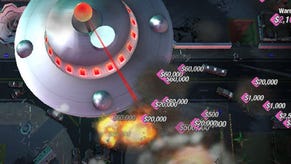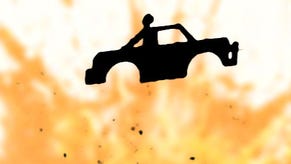Burnout Crash!
Demolition in motion.
From this simple basis, various game modes tweak things in fun directions. Rush Hour mode requires you to simply wreak as much havoc as possible in 90 seconds. More strategic is Road Trip, which has more of a survival spin. Here you have to prevent a certain number of vehicles from making it across the screen. This means you have to think more about where to causes crashes, where to build up walls of wreckage and take into account the area of effect of your explosions. In the third and final mode the game only ends when all fires are extinguished. Making sure not to completely destroy everything, while leaving enough vehicles damaged to keep the clock ticking, is a real test of control and forward planning.
There are no score multiplier icons this time, but in their place comes a whole slew of bonuses that can be earned by smart play. Destroy a pizza truck and you get to spin a cheese-and-tomato topped wheel of fortune, which can enhance or decrease your scoring potential. Bulldozers might grind through the level, clearing a path through your debris to the strains of Salt N' Pepa's “Push It”. Detonate the secret golden car in each stage and you get a multi-million points boost, accompanied by a burst of Spandau Ballet's “Gold” for good measure. Sinkholes might open up, granting extra points for any cars shunted into their murky depths. Sharks can be unleashed, because why not? Each stage is crammed with things to explode, and it's clear that finding the best strategies for high scores is what will keep players coming back.
The leaderboard aspect is augmented by the Crash Wall, a take on Criterion's Autolog feature. This constantly updates with scores from friends, working out stats and rankings on the fly and suggesting urgent challenges that you should respond to before your place slips lower down the scoreboard.
"Ambulances are the only vehicles that are off-limits. Destroy those and you'll be penalised."
The “pinball and gameshows” concept sounds weird in practice, but makes total sense when playing. This is a game that wants to plaster a big silly grin across your face, the joy of creating a ground-shattering cascade of explosions every bit as satisfying as the rainbows and fireworks of a high scoring Peggle round. It's a primal thing, and Criterion is refreshingly unapologetic in its pursuit of base gaming pleasure. It may lack the notional realism of Burnout's past, but it amplifies the sheer lunatic abandon of mass destruction beyond anything that could be portrayed in a traditional racing game engine.
But what of Kinect? Motionphobic players will be pleased to learn that the game also supports normal joypad play, but this is still very much a game that works best when married to the shameless titting about that motion control brings. After a brief steer-with-your-hands starting run, it's all about jumping to set off explosions, then leaning to move the car while in mid-air. It's intuitive and, more importantly, surprisingly accurate. These are movements you instinctively make during a racing game, all Crash does is amplify and reward them with cartoon levels of apocalyptic mayhem. Having tried two rounds, one with Kinect and one with a controller, I was surprised to find that I scored far higher with my wobbling and stamping than I did with fingers and thumbs.
The enduring impression is one of fun, a word that often loses its meaning in gaming, where mindless distractions are easy to justify. Burnout Crash is anything but mindless. Gaudy, noisy and deliciously silly, it may not be the spin-off that fans wanted or expected, but set aside your prejudice and it may just prove to be every bit as ridiculous and addictive as its more traditional cousins.



